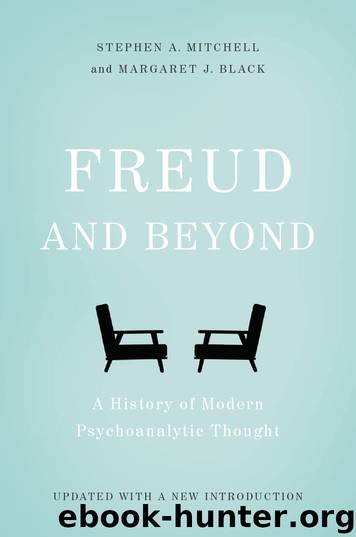Freud and Beyond by Stephen A. Mitchell

Author:Stephen A. Mitchell
Language: eng
Format: epub
ISBN: 9780465098828
Publisher: Basic Books
Published: 2016-03-22T04:00:00+00:00
OTHER INDEPENDENT GROUP INNOVATORS
The other major innovative figures in the “independent” group of the British Psychoanalytic Society were Michael Balint, John Bowlby, and Harry Guntrip. The authors of this group were independent not only in relation to the Kleinians and (Anna) Freudians, but also from each other. They all drew heavily on the work of Melanie Klein, and they all shifted their emphasis from conflicts between drives and defenses to the establishment and maintenance of relations with others. However, they each did this in their own distinctive fashion.3
From Ferenczi to Balint
Michael Balint (1896–1970) was analyzed by Sandor Ferenczi and, in many respects, Balint’s contribution was an extension of Ferenczi’s. Ferenczi (1873–1933) had been one of the most innovative of Freud’s early disciples, both in theory and in clinical practice. In the last several years before his death, Ferenczi had become more and more preoccupied with the impact of early deprivation on personality development, placing a central emphasis on early, chronic trauma, including sexual experiences. This was a return to the perspective Freud had rejected in abandoning the theory of infantile seduction in 1897 in favor of his theory of instinctual drive and the centrality of fantasy.
Ferenczi was also an innovator with respect to clinical technique. Consistent with his theoretical emphasis on trauma and deprivation, he became more and more convinced of the importance of the analyst providing a measured love and affection, rather than abstinent nongratification of the patient’s needs and wishes. He also objected to what he felt was the hierarchical, authoritarian arrangement of the traditional analytic relationship between an analyst who dispenses interpretations and a patient who receives them. This led to brief, quickly abandoned experiments with “mutual analysis” between patient and analyst in which they took turns lying on the couch and free-associating.4
As the analyst of Balint, as well as of Melanie Klein and Clara Thompson, Ferenczi was a key figure in the transitions from Freud’s work to several of the most important currents of contemporary psychoanalytic thought. Balint’s extension of Ferenczi’s innovations led him to the conviction that what patients, particularly more disturbed patients, are seeking in the analytic situation is not gratification of infantile sexual and aggressive wishes, but an unconditional love, a “primary object love,” they were deprived of in childhood. Unlike Fairbairn, Balint never rejected Freud’s drive theory; yet, like Fairbairn, Balint argued that object relations are not derivatives of drives but are present at the beginning of life. “This form of object relation [primary object love] is not linked to any of the erotogenic zones; it is not oral, oral-sucking, anal, genital, etc., love, but is something on its own” (1937, pp. 84–85).
In Balint’s view, the earliest relationship with the mother is a passive state experienced as a “harmonious, interpenetrating mix-up” of “primary substances” (1968, p. 66). It is out of this passive state that more active forms of relating and pleasure-seeking arise. A rupture in this early relationship creates what Balint terms “the basic fault,” a fragmentation and disjunction at the
Download
This site does not store any files on its server. We only index and link to content provided by other sites. Please contact the content providers to delete copyright contents if any and email us, we'll remove relevant links or contents immediately.
| Administration & Medicine Economics | Allied Health Professions |
| Basic Sciences | Dentistry |
| History | Medical Informatics |
| Medicine | Nursing |
| Pharmacology | Psychology |
| Research | Veterinary Medicine |
The Art of Thinking Clearly by Rolf Dobelli(10223)
The 5 Love Languages: The Secret to Love That Lasts by Gary Chapman(9589)
Mindhunter: Inside the FBI's Elite Serial Crime Unit by John E. Douglas & Mark Olshaker(9201)
Becoming Supernatural by Dr. Joe Dispenza(8119)
Nudge - Improving Decisions about Health, Wealth, and Happiness by Thaler Sunstein(7615)
The Road Less Traveled by M. Scott Peck(7522)
Enlightenment Now: The Case for Reason, Science, Humanism, and Progress by Steven Pinker(7235)
Mastermind: How to Think Like Sherlock Holmes by Maria Konnikova(7227)
Win Bigly by Scott Adams(7094)
The Way of Zen by Alan W. Watts(6506)
Factfulness: Ten Reasons We're Wrong About the World – and Why Things Are Better Than You Think by Hans Rosling(4694)
The State of Affairs by Esther Perel(4642)
Gerald's Game by Stephen King(4583)
Man's Search for Meaning by Viktor Frankl(4425)
The Confidence Code by Katty Kay(4187)
Thinking in Bets by Annie Duke(4153)
The Healing Self by Deepak Chopra(3474)
Hidden Persuasion: 33 psychological influence techniques in advertising by Marc Andrews & Matthijs van Leeuwen & Rick van Baaren(3472)
The Worm at the Core by Sheldon Solomon(3435)
